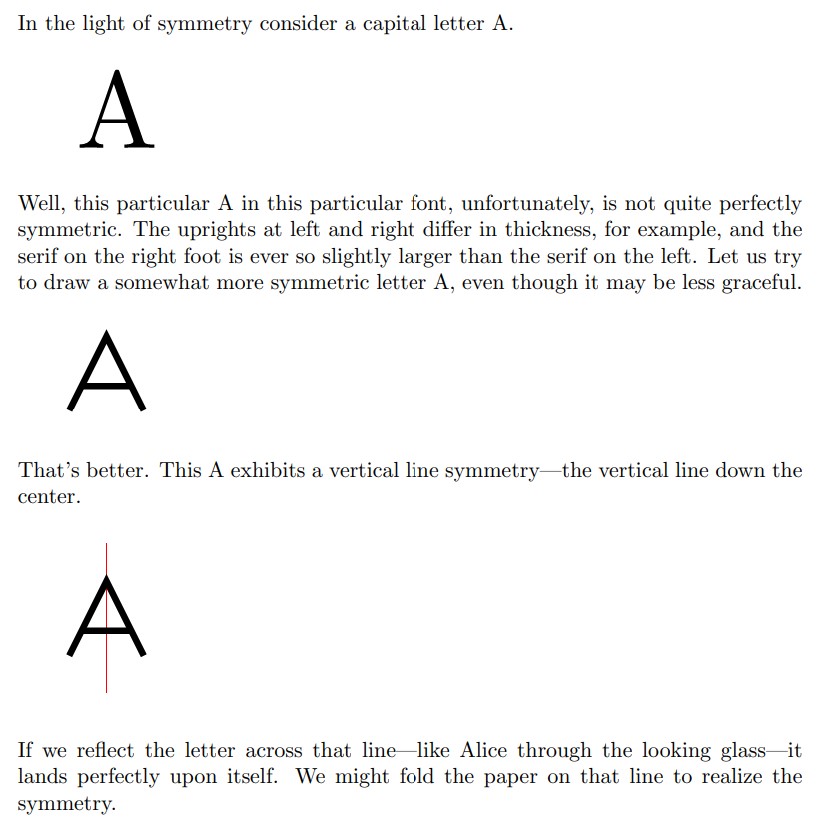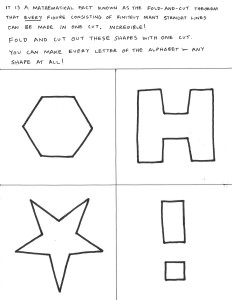Today I had the pleasure to visit my daughter’s fourth-grade classroom for some fun mathematical activities. The topic was Symmetry! I planned some paper-folding activities, involving hole-punching and cutting, aiming to display the dynamism that is present in the concept of symmetry. Symmetry occurs when a figure can leap up, transforming itself through space, and land again exactly upon itself in different ways. I sought to have the students experience this dynamic action not only in their minds, as they imagined various symmetries for the figures we considered, but also physically, as they folded a paper along a line of symmetry, checking that this fold brought the figure exactly to itself.
The exercises were good plain fun, and some of the kids wanted to do them again and again, the very same ones. Here is the pdf file for the entire project.
To get started, we began with a very simple case, a square with two dots on it, which the girls folded and then punched through with a hole punch, so that one punch would punch through both holes at once.
Next, we handled a few patterns that required two folds. I told the kids to look for the lines of symmetry and fold on them. Fold the paper in such a way that with ONE punch, you can make exactly the whole pattern.
Don’t worry if the holes you punch do not line up exactly perfectly with the dots — if the holes are all touching their intended target and there are the right number of holes, then I told the kids it is great!
The three-fold patterns are a bit more challenging, but almost all of the kids were able to do it. They did need some help punching through, however, since it sometimes requires some strength to punch through many layers.
With these further patterns, some of the folds don’t completely cover the paper. So double-check and make sure that you won’t end up with unwanted extra holes!
The second half of the project involved several cutting challenges. To begin, let’s suppose that you wanted to cut a square out of the middle of a piece of paper. How would you do it? Perhaps you might want to poke your scissors through and then cut around the square in four cuts. But can you do it in just ONE cut? Yes! If you fold the paper on the diagonals of the square, then you can make one quick snip to cut out exactly the square, leaving the frame completely intact.
Similarly, one can cut out many other shapes in just one cut. The rectangle and triangle are a little trickier than you might think at first, since at a middle stage of folding, you’ll find that you end up folding a shorter line onto a longer one, but the point is that this is completely fine, since one cut will go through both. Give it a try!
Here are a few harder shapes, requiring more folds.
It is an amazing mathematical fact, the fold-and-cut theorem, that ANY shape consisting of finitely many straight line segments can be made with just one cut after folding. Here are a few challenges, which many of the fourth-graders were able to do during my visit.
What a lot of fun the visit was! I shall look forward to returning to the school next time.
In case anyone is interested, I have made available a pdf file of this project, below:
I would like to thank Mike Lawler, whose tweet put me onto the topic. And see also the awesome Numberphile video on the fold-and-cut theorem, featuring mathematician Katie Steckles.
See more of my Math for Kids!





















